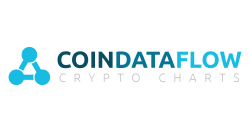The arts appeared on the official S.T.A.L.K.E.R. public. The bogs were the starting location in the independent supplement “Clean Sky”, released in 2008 – they were based on members of the group “Clean Sky”, who were at war with the “Renegades”. The exact release date of S.T.A.L.K.E.R. 2 not yet. The game will be a temporary Xbox console exclusive and will be available on PC and Xbox Series at launch.
Lance MacDonald, known for finding clipped content from FromSoftware games and creating mods for them, shared his information about Elden Ring during a stream on Twitch.
According to MacDonald, he followed the FromSoftware contractors and found out what one of them was doing. Judging by the content of the work of this employee, as McDonald said, Elden Ring should be in the final stages of production.
The blogger noted that he does not know whether the game will be shown at the awards ceremony of The Game Awards 2020, which will take place in December or not.
Using a crypto portfolio in Excel might look like a badge of sophistication – tidy rows, private calculations, and highlighter-pen green gains. But behind that appearance of control lies a time bomb: each entry by hand doubles the potential for expensive errors. What was good enough for small test portfolios no longer tolerates the stresses of contemporary multi-exchange, multi-chain trading.
As crypto investing becomes ever more active, spreadsheets fall behind. The formulas that pretended to masterfulness now perplex, and man fatigue is the largest financial risk. The question in 2025 is no longer whether or not you should look beyond Excel – it’s how far into the future you can not afford not to.
Introduction: When Spreadsheets Stop Being “Good Enough”
Once the ultimate self-made man of trading tools, Excel was once responsible for everything from ROI tracking to profit summaries. But as portfolios matured – across dozens of wallets, hundreds of trades, and many blockchains – the breakpoints became too far to ignore.
The myth of full control through Excel
Most investors still feel that spreadsheets provide them with “entire control” or “full control” of their portfolios. They have full view of every number, every cell, every formula. But this is an illusion. Excel does not automatically verify blockchain data or trading fees. It does not alert them if a transaction is missing or if a price feed is no longer updating.
The feeling of precision typically obscures the fact that the data set is already wrong – perhaps by thousands of dollars.
Take a typical example: an investor is typing trades manually from Binance, Coinbase, and Metamask. A missed or repeated entry distorts ROI by 5–10%. The investor would believe they are up, while actual PnL is in the red.
How portfolio complexity exceeded manual tools
When crypto was largely Bitcoin and Ethereum, a single piece of paper was able to manage it all. But DeFi, NFTs, staking rewards, and several stablecoins now overwhelm portfolios with hundreds of microtransactions. Each one inserts rounding errors, timing errors, or token misclassifications.
Even experienced spreadsheet professionals can’t normalize data that freely crosses exchanges or time zones. By the time they’ve matched up a month’s data, the market is moving – along with their portfolio.
A standard middle-size dealer nowadays trades with:
- 5–10 interchanged exchanges and purses
- More than 200 orders monthly
- Base price, multiplier, and target lockups
Attempting to tie everything together in Excel is no longer “manual tracking” – it’s free accounting work.
Why crypto accounting mistakes replicate quicker than conventional finance
In conventional portfolios, trades pass through central intermediaries – brokers, custodians, or banks. Crypto is not like that. Transactions are typically asynchronous, decentralized, and tokenized in assets that move minute by minute.
This imposes compounding inconsistencies that aren’t designed for by Excel. A cost basis with old prices can wrongly report profits for a full batch of trades. And if you import with APIs or CSVs, minor variations in timestamp formatting will wreak havoc with your cost basis logic.
The consequence? By hand Excel monitoring doesn’t merely waste time – it demolishes precision and confidence. Every round of reconciliation causes stress, doubt, and an ever-growing sense that your information no longer agrees with reality.
The Hidden Costs of Manual Portfolio Tracking
Most investors believe the actual cost of keeping tabs manually is time. In fact, it’s inaccuracy, lost opportunities, and emotional exhaustion. No edit feels productive – until that edit conceals a blip that grows worse with time. A supposedly quick glance at balances can result in confusion, stress, and even incorrect tax returns.
Inaccuracy and lost transactions
Crypto data is not like regular accounting data. It is decentralized, volatile, and sometimes incomplete. Manually copying this data into Excel is where investors fall prey to errors stealthily – missing fees, incorrect transaction orders, or outdated price conversions.
Real-world scenarios of wrong ROI/PnL
Suppose this: a user manually follows trades on Binance, Kraken, and several wallets. One day they copy data from a day-old API export or mislabel a trade type (a swap recorded as a purchase).
That one mistake inflates ROI by 12%, misleading the user into holding a losing position longer than they should.
In another case, a spreadsheet formula points to a broken cell range after data is sorted. The PnL column still updates – but with incorrect inputs. Investors often discover too late that their “profit” figures were based on corrupted logic for weeks.
How data fragmentation between wallets induces multiplying errors
Crypto investors hold assets on many platforms: centralized exchanges, on-chain wallets, staking pools, and NFTs. There is no native way in Excel to combine these sources. Every time a CSV or blockchain explorer is imported, new inconsistencies arise – different timestamp formats, missing decimals, and unrecognized tokens.
Even tiny mismatches multiply. If one wallet uses UTC+0 timestamps and another uses local time, ROI for cross-platform trades gets skewed. Manual reconciliation doesn’t just take hours – it erodes data integrity.
Example of typical manual errors
| Error | Consequence |
| Incorrect token symbol (e.g., USDT vs. USD₮) | ROI reduced by 2–3% due to mismatched price feed |
| Duplicate CSV imports | Portfolio value exaggerated |
| Ignored network fees | PnL overstated by up to 10% |
| Deleted hidden columns by accident | Broken cost-basis chain |
In essence, each manual correction poses a new risk. Accuracy becomes a moving target – and investors pay for it with both time and money.
Time wastage and emotional exhaustion
Even if you can avoid major errors, the time expense of manual tracking is enormous. Price updates, cleaning data, fixing formulas – it’s a continuous loop. For active traders, this may take several hours a week – time better spent on research or strategy.
When you become your own data entry clerk
Manually keeping up with trades might feel empowering at first. Over time, it starts to feel like punishment. Every new wallet, airdrop, or staking reward becomes just another record to maintain. Instead of investing, you’re running a one-person accounting department.
A small portfolio with 200 monthly transactions might require:
- 5–6 hours for importing and cleaning data
- 2 hours for verifying ROI formulas
- 1 hour fixing formatting or “#REF!” errors
That’s nearly a full workday – every month.
The burnout effect from chasing “consistency”
The more detail-oriented you are, the more frustrating Excel becomes. Every decimal misalignment, rounding issue, or duplicate entry undermines the entire sheet. This leads to what many experience as crypto spreadsheet fatigue – a mix of paranoia and anxiety that something’s wrong, even if the sheet “looks fine.”
Emotional fatigue builds slowly. You stop updating data, delay reconciliations, and lose sight of actual profits. And that’s often when big financial mistakes occur – delayed decisions, overexposure, or missed exits.
Security and privacy threats
Spreadsheets appear safe because they’re “offline,” but they usually aren’t. Files are emailed, uploaded to Google Drive, or opened on multiple devices – with no encryption or access control.
Human mistakes in public file sharing
In 2024, several Reddit users accidentally shared public Google Sheets containing wallet addresses and transaction data. Some even exposed private notes and API keys inside macros. Unlike professional portfolio trackers, spreadsheets have no built-in privacy layers.
A lost link or accidental file sync can expose your entire portfolio to anyone. Once leaked, the data can’t be recovered.
Lack of encryption and backup practices
Most Excel files rely on basic passwords – easy to bypass with simple tools. There’s no version history for offline files, so one accidental overwrite can delete months of tracking.
Professional platforms, on the other hand, use encrypted cloud backups, 2FA, and detailed access controls.
| Risk Type | Common Scenario | Impact |
| Shared Google Sheet | Public link accidentally shared | Exposure of portfolio and wallet addresses |
| File corruption | Local Excel crash | Loss of entire data file |
| Weak password | “1234” or none | Easy unauthorized access |
| No backup | Laptop stolen | Irrecoverable portfolio history |
When crypto worth thousands is on the line, relying on unsecured spreadsheets is more than inconvenient – it’s reckless.
1. CoinDataFlow
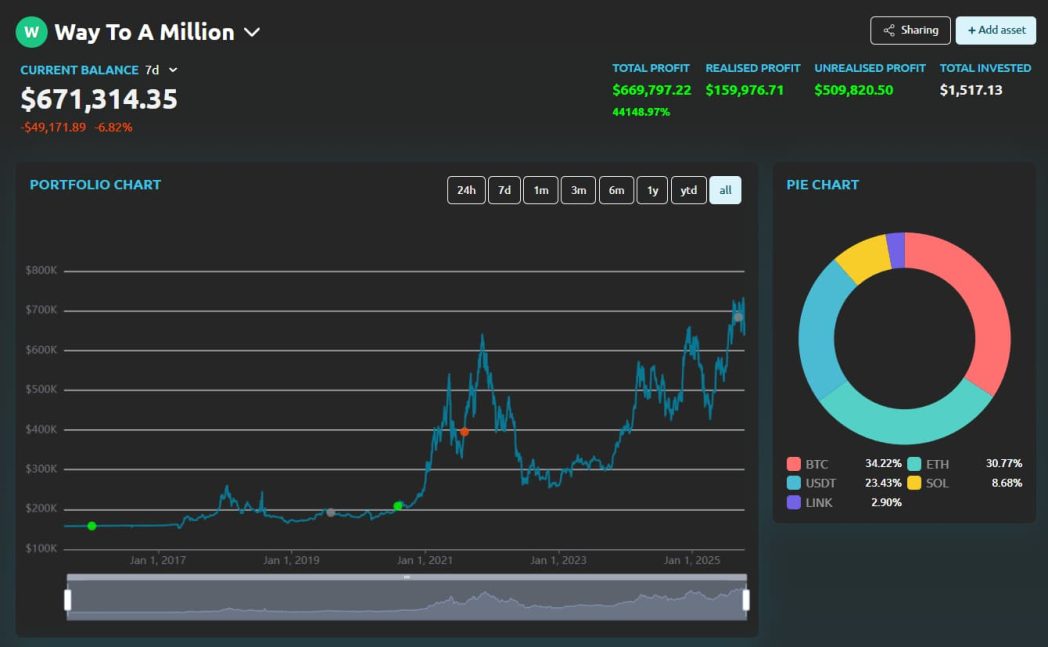
https://coindataflow.com/en/portfolio-tracker
Before we talk about alternatives, let’s begin with the product that best shows what ditching Excel really does. CoinDataFlow was built for spreadsheet-weary investors – users still wanting maximum transparency and control, but without the fear of broken functions or stale information.
Moving on from spreadsheets to structured portfolio tracking
Transcending from Excel to a structured tracker can feel like sacrificing freedom. CoinDataFlow eliminates that feeling by maintaining user control while automating the technical work Excel struggles to handle. Rather than importing files manually, you simply connect your exchanges and wallets directly. Data syncs in real time, with each transaction automatically categorized, priced, and historically recorded.
The transition takes minutes: connect your exchange APIs or wallets, and the platform instantly rebuilds your cost basis, realized and unrealized PnL, and overall performance over time. Unlike a spreadsheet, CoinDataFlow retains complete historical consistency – meaning your old trades stay accurate even as token prices fluctuate.
Feature Comparison
| Function | Excel (Manual) | CoinDataFlow (Automated) |
| Data entry | Manual CSV imports | Real-time API sync |
| Cost basis | Static formulas | Dynamic calculation per trade |
| PnL updates | Manual refresh needed | Instant with live prices |
| Historical consistency | Risk of overwriting data | Immutable records |
Real-time ROI and PnL reports without manual entry
For both short-term traders and long-term investors, the greatest value is precision. CoinDataFlow calculates both realized and unrealized profits in real-time using precise timestamps and exchange-provided fee data. Your portfolio reflects the actual market position – not yesterday’s estimates.
The software also automatically reconstructs transaction sequences. For example, if you bought Bitcoin on three different exchanges and sold portions over several months, CoinDataFlow correctly groups those trades to calculate real ROI – without writing a single formula.
This automation fixes one of Excel’s core problems: the delay between recorded data and actual activity. While spreadsheets depend on user discipline, CoinDataFlow ensures updates are accurate by default.
Pros: Precision, historical consistency, no data loss from sync
Investors often expect a steep learning curve when moving from Excel, but CoinDataFlow’s interface is designed to feel intuitive. The dashboards are clean and organized – ROI and PnL take center stage, with side panels showing allocations, balance history, and analytics per asset.
Three standout benefits:
- Accuracy – Every transaction is priced at the exact moment, including fees and exchange rates.
- Historical integrity – Older data stays valid even as new trades are added.
- No data loss – API sync prevents skipped or duplicated records, a common issue in CSV imports.
The result is a portfolio view that feels definitive. You don’t have to question if the numbers are right – you can act on them.
Cons: Lacks deep tax filing automation but excels in daily intuitiveness
CoinDataFlow prioritizes analytics over taxes. While users can export data for tax software, it doesn’t generate forms or offer jurisdiction-specific reports. That trade-off makes sense: the tool is designed for users who care more about performance accuracy than tax compliance.
Where competitors overload dashboards with tax-focused features, CoinDataFlow keeps reporting fast and usable. Investors get daily clarity and peace of mind – which is the true value of automation for most.
2. CoinGecko
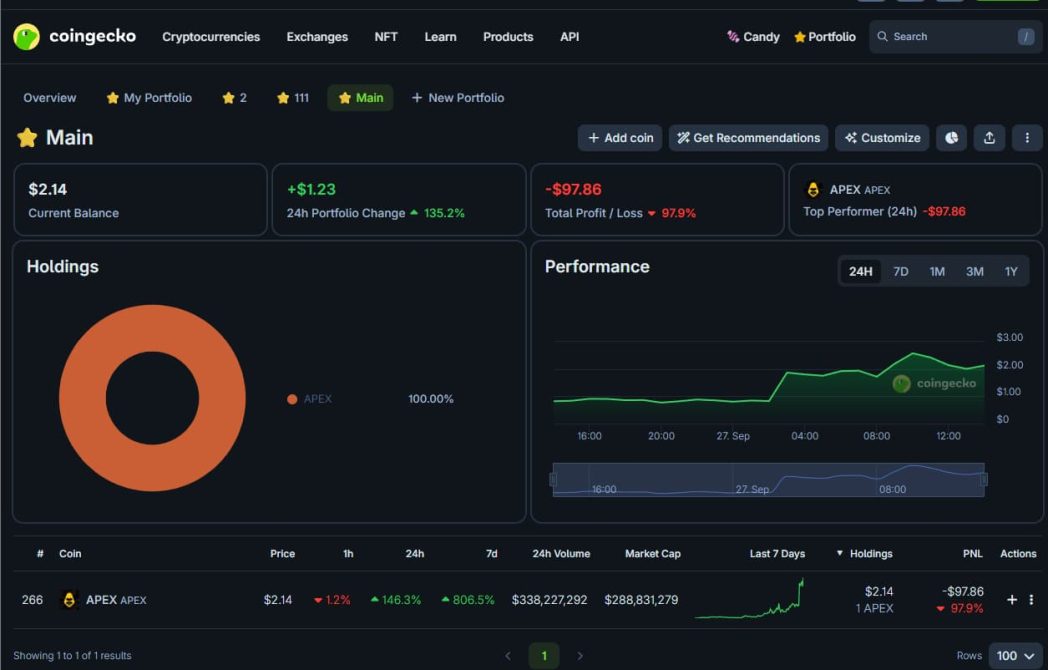
https://www.coingecko.com/en/portfolio
CoinGecko has been a familiar name in the world of crypto for a long time, first and foremost due to market data aggregation. The Portfolio function allows that functionality to extend into asset monitoring with a simple, browser-based way to review holdings. It’s best suited for newcomers looking for a free and familiar starting point before moving on to more advanced platforms.
Open and user-friendly for the newcomers
CoinGecko is often the first platform that many retail investors use to “track” a portfolio. Access is easy – no account is strictly necessary, and coins can be manually added in just a few minutes. Balances and valuations update automatically using the same data feeds that power CoinGecko’s market listings.
This low barrier to entry makes it ideal for beginners who are still learning the basics of ROI and portfolio diversification. You can open a browser tab, enter your Bitcoin and Ethereum holdings, and instantly see the value of your portfolio in your preferred currency.
That said, the simplicity comes with trade-offs. Since everything is entered manually, users are responsible for their own accuracy. There’s no automatic transaction sync from exchanges or wallets. CoinGecko doesn’t offer API connections, so tracking multiple assets or frequent trades quickly becomes tedious.
| Strength | Description | Ideal for |
| Accessibility | Free and easy to start | Beginners |
| Interface | Familiar CoinGecko design | Users who check markets daily |
| Data source | CoinGecko’s live price feed | Long-term holders |
Pros: Convenient setup, elegant design
The interface is clean and simple – especially for users already familiar with CoinGecko’s main site. The portfolio page follows the same visual style: minimal clutter, clear typography, and straightforward charts.
You can manage multiple portfolios, change currencies, and track your gains or losses over time. For those transitioning from Excel or Google Sheets, the interface feels lightweight and intuitive. There’s no steep learning curve or technical setup – just enter your assets and watch the numbers update automatically.
Many users value this simplicity. It’s the kind of tool you can check during a coffee break without worrying about integrations or tax complications.
Cons: No sophisticated calculations or export function
The biggest limitation is analytical depth. While CoinGecko displays basic profit and loss percentages, it doesn’t distinguish between realized and unrealized gains – which can lead to misleading conclusions, especially for users who frequently trade the same asset.
There’s also no cost-basis tracking or historical transaction view. You can’t, for instance, calculate your average entry price over multiple purchases or generate data for tax reporting.
Another major shortcoming is the lack of export features. Users looking to archive data or switch platforms have no built-in option to download portfolio history. This means data management is still manual – much like Excel, but with fewer customization options.
| Limitation | Impact | Workaround |
| No API sync | Requires manual updates | Periodic re-entry |
| No realized/unrealized split | Harder to gauge actual ROI | Use an external tracker |
| No export feature | Data stuck in platform | Manual screenshots |
In short, CoinGecko Portfolio works best as a beginner’s tool – a gentle introduction to portfolio tracking that doesn’t overwhelm. But once your holdings grow beyond a handful of assets, most users outgrow its simplicity and move on to platforms with automation and deeper analytics.
3. Zerion
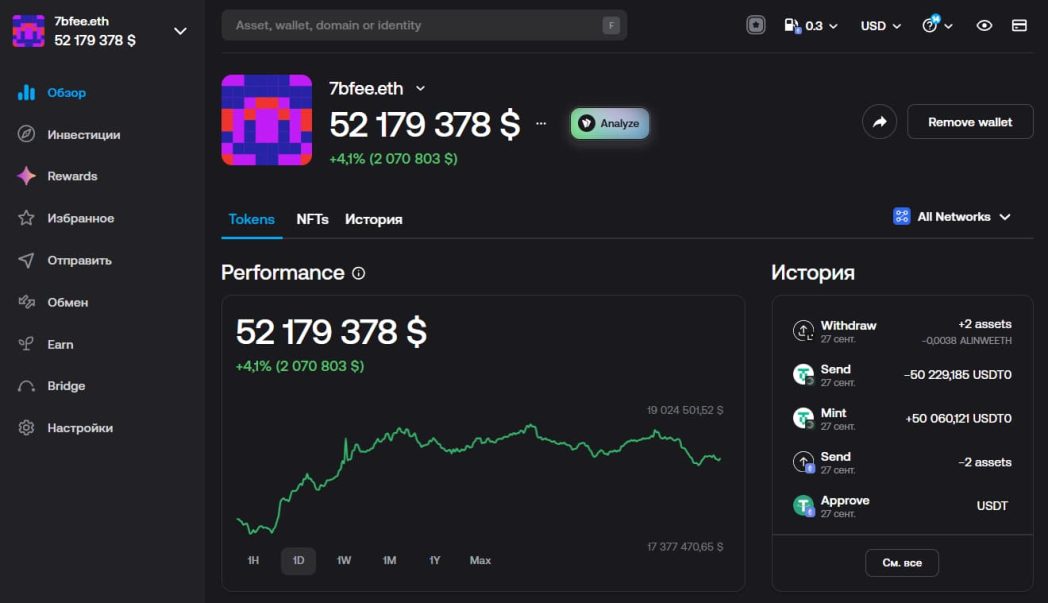
Zerion marks a clear departure from traditional tracking methods, moving toward DeFi-native portfolio management. While many platforms began by supporting centralized exchange (CEX) data, Zerion was built from the ground up to focus on wallets, tokens, and on-chain activity. It’s tailored for investors deeply embedded in decentralized ecosystems who want real-time insight across multiple blockchains.
Why DeFi-oriented users abandon manual Excel sheets
Managing a DeFi portfolio in Excel is nearly impossible. Transactions span multiple blockchains, smart contracts, and liquidity pools – none of which use centralized record-keeping. Zerion tackles this challenge directly by connecting to user wallets like MetaMask or Ledger and aggregating live data across chains.
Rather than importing CSVs or manually entering prices, Zerion pulls everything on-chain: token balances, pending rewards, NFT assets, and current DeFi positions. The app updates as transactions occur, giving you a real-time snapshot of your digital footprint.
If you’ve ever tried to reconcile Uniswap liquidity positions or monitor yield farming returns with a spreadsheet, this automation feels like a breath of fresh air. Zerion is one of the few tools that treats decentralized finance as a native environment – not a bolted-on feature.
Feature Comparison
| Function | Manual (Excel) | Zerion (Automated) |
| Data source | Manual DeFiScan/CSV | Direct wallet connections |
| Supported networks | User-dependent | 10+ major blockchains |
| NFT tracking | Manual text entries | Built-in visualization |
| DeFi rewards | Not trackable | Real-time yield display |
Pros: Frictionless wallet sync and intuitive on-chain visualization
Zerion’s biggest strength is clarity. The interface makes complex blockchain data easy to understand at a glance. Assets are neatly grouped by chain and category, with token values, NFTs, and yield opportunities shown side-by-side.
Users can toggle between Ethereum, Polygon, Arbitrum, and other supported networks in seconds. The mobile app is especially smooth, offering clean transitions and a polished interface without losing detail.
Other helpful features include customizable alerts for wallet activity, price swings, or gas fees. For DeFi investors who engage with blockchain daily, this streamlined experience is a major time-saver.
Zerion also prioritizes privacy. You only need to connect your public wallet address – no KYC or personal info required.
Cons: Limited integration with centralized exchanges
Zerion’s greatest strength – being DeFi-first – is also its main limitation. If your assets are split between Binance, Coinbase, Kraken, or other CEX platforms, Zerion alone won’t give you a full picture of your portfolio.
There’s no automatic API sync for exchanges, so off-chain holdings must be entered manually or estimated. For hybrid investors using both centralized and decentralized platforms, this results in a fragmented view.
Another shortfall is tax reporting. Since Zerion doesn’t track cost basis or separate realized from unrealized gains, it isn’t built for accounting or compliance. Its focus is real-time visibility – not bookkeeping.
| Limitation | Impact | Affected Users |
| No exchange sync | Incomplete portfolio view | Hybrid CEX/DeFi investors |
| No cost-basis data | No PnL accuracy | Traders and tax filers |
| Limited reporting | No export formats | Professionals needing reports |
Zerion is an excellent choice for DeFi-native users who prioritize visibility, speed, and privacy. But for those seeking a unified analytical view of both exchange and on-chain assets, it functions best as a supplementary tool – not a full replacement.
4. Koinly
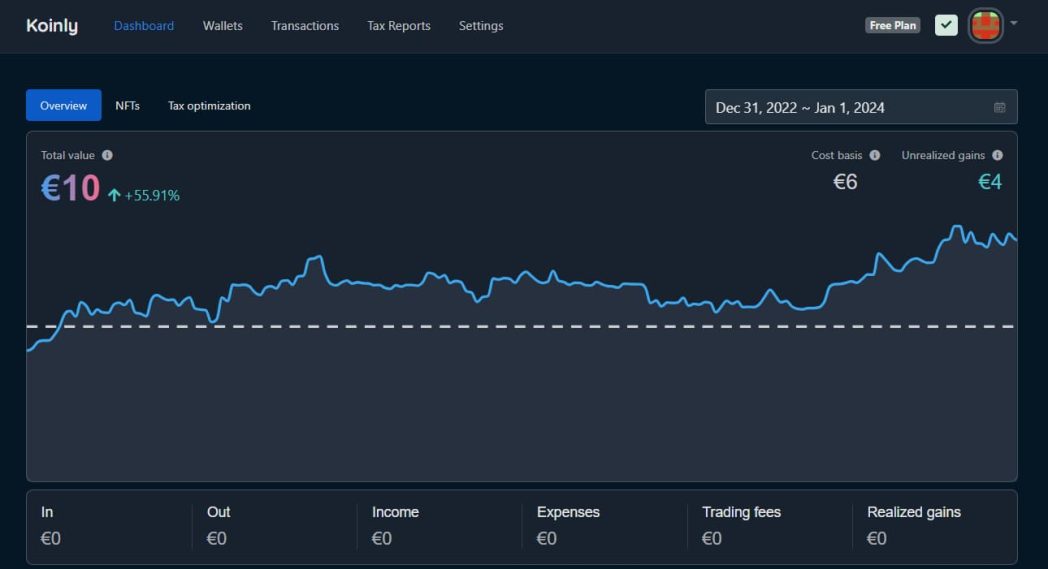
https://koinly.io/crypto-portfolio-tracker/
Koinly has earned a reputation among crypto investors who don’t just want their portfolios tracked – they need them tax-ready. While many tools focus on visualizing profit and loss, Koinly goes further by turning that data into something accountants and regulators can actually use. It’s not the flashiest tool, but it’s one of the most technically accurate when it comes to calculating cost basis and realized gains.
Mechanical tax and profit calculations vs. risk of human error
Many investors underestimate just how complex crypto taxes become when juggling multiple wallets, exchanges, and blockchains. Trying to do it manually – even with Excel – nearly always leads to errors. Koinly automates the process by pulling transaction data via APIs, matching deposits and withdrawals, and calculating capital gains according to country-specific tax rules.
This removes the need to manually match every buy and sell. Koinly calculates the correct cost basis for each sale using accounting methods like FIFO, LIFO, or ACB based on your region.
Example: How automation avoids expensive errors
| Example Transaction | Manual (Excel) Outcome | Koinly Outcome |
| 3 BTC purchased, 1 BTC sold later | Mixed cost basis, incorrect ROI | Accurate realized gain with fees applied |
| Multiple wallets with DeFi transfers | Internal transfers counted as sales | Automatically detected as internal move |
| Staking rewards from exchange | Not tracked | Automatically added as income |
This automation essentially transforms Koinly from a simple tracker into a full-blown smart accounting system – one that scales far beyond the limits of spreadsheets.
Pros: Cost basis accuracy and regulatory compliance
What makes Koinly especially valuable is its ability to bridge tracking with regulatory compliance. Users can generate localized tax reports, export data to accounting software, and compare realized versus unrealized gains in one place.
It’s also one of the few platforms that supports both crypto-native assets (like DeFi, NFTs, and staking) and traditional financial instruments in a single report – a key advantage for hybrid investors.
Other notable benefits:
- Multi-country support with customizable tax methods
- Transparent and auditable calculation logic
- Direct exports to platforms like TurboTax, TaxAct, and Xero
For investors operating across different tax jurisdictions, Koinly offers the peace of mind that spreadsheets simply can’t guarantee.
Cons: Costly for small investors, occasional API mismatches
Koinly’s power comes at a price. Its free version is very limited, and full reporting features are behind a paywall – often too steep for casual traders. Pricing is based on transaction volume, so active users end up paying more.
API stability is another challenge. Although Koinly supports hundreds of exchanges and blockchains, API keys sometimes fail or return incomplete data. The system flags these errors, but users may still need to re-sync or upload CSV files manually.
Lastly, the interface – while detailed – can feel overwhelming at first. Every transaction, transfer, and gain is visible on-screen. For users seeking a simple overview, it might feel more like accounting software than a portfolio tracker.
| Limitation | Impact | Solution |
| High pricing | Expensive for small portfolios | Stick to the basic plan without tax export |
| API mismatches | Missing transactions | Re-sync manually or import CSV |
| Dense interface | Overwhelming for new users | Use dashboard-only simplified view |
Koinly is ideal for investors who care as much about precision and compliance as they do about performance. It’s not just a tracker – it’s a financial control system. Excellent for professionals, but possibly overkill for beginners.
5. CoinTracking
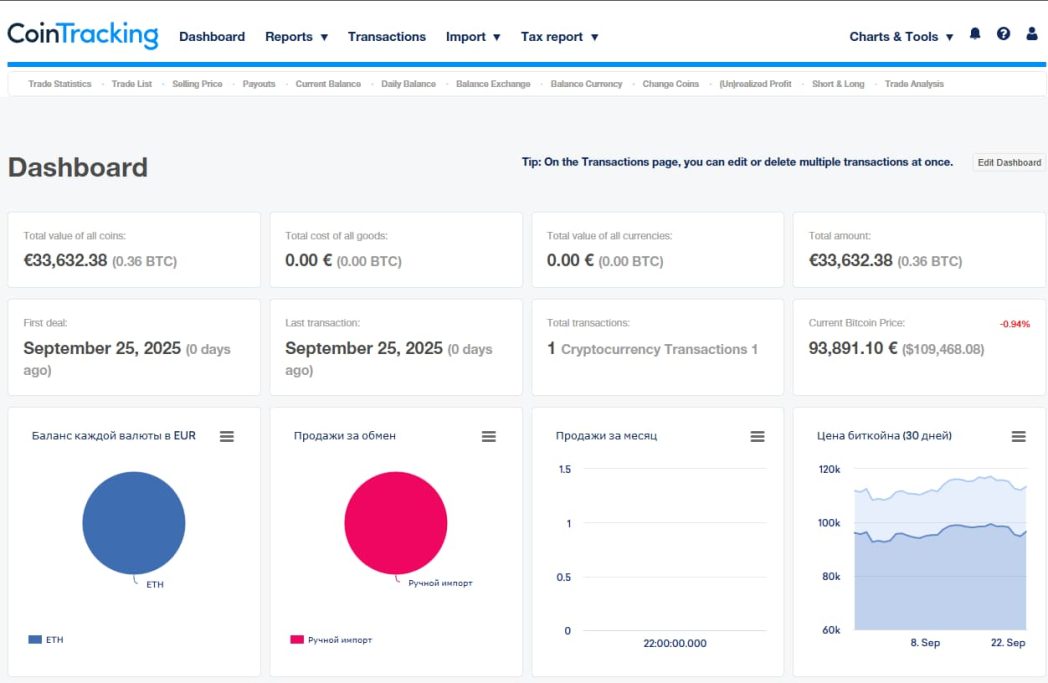
https://cointracking.info/crypto-portfolio-tracker
CoinTracking is one of the oldest and most data-rich portfolio trackers in the crypto space. Long before “automated dashboards” became the norm, CoinTracking had already made its mark as the go-to tool for serious analytics and in-depth transaction history tracking. Today, it continues to be a powerhouse for users who need deep visibility into their ROI, PnL, and tax responsibilities – though its complexity still divides opinion.
Import from Excel – when automation pays off
CoinTracking is especially attractive to users migrating from Excel or Google Sheets. It offers powerful import tools that convert spreadsheet-based manual entries into a structured portfolio record. Once imported, the platform automatically categorizes trades, detects wallet transfers, and generates historical ROI charts.
This functionality highlights the weakness of manual tracking. A typical Excel file might hold 500–1,000 transactions, which could take days to reconcile manually. CoinTracking processes the same data in minutes, using consistent cost-basis logic and catching duplicates or missing trades.
| Task | Excel (Manual) | CoinTracking (Automated) |
| Trade import | Manual copy-paste | Auto-detect via CSV/API |
| Cost-basis calculation | Error-prone formulas | Algorithmic precision |
| Cross-wallet matching | Nearly impossible manually | Fully automated |
| Historical charts | Built by hand | Interactive and built-in |
By visualizing long-term performance, CoinTracking helps users understand how their investment strategies evolve – not just how balances change day to day.
Pros: Unmatched depth of analytics
CoinTracking’s biggest strength lies in its granularity. Users can access realized/unrealized gains, daily profits, asset allocation, and even tax-optimized strategies.
Its database handles virtually every transaction type – from margin trades and airdrops to staking rewards and DeFi operations. This makes it especially suitable for advanced traders operating across multiple exchanges and wallets.
The platform’s reporting capabilities go far beyond basic portfolio apps. You can export data for tax filing, analyze holdings in over 30 fiat currencies, and generate detailed income reports for long-term accounting.
Other standout features include:
- API integrations with over 70 major exchanges
- Automatic detection of internal transfers
- Historical price data for each supported coin, going back years
For crypto professionals or business operators, CoinTracking provides an all-in-one system for accurate and detailed record-keeping.
Cons: Intimidating interface and steep learning curve
The downside to CoinTracking’s power is its complexity. The interface looks outdated and cluttered, especially on smaller screens. For new users, navigating its many menus and configuration options – especially for tax settings – can be overwhelming.
Even though automation is strong, niche cases (such as obscure tokens or smaller DEX trades) may still require manual adjustment, making the onboarding process more demanding than simpler tools.
Cost is another factor. The free version limits users to a small number of transactions, and advanced reports require paid subscriptions – which scale quickly with usage.
| Limitation | Description | Who It Affects |
| Complex UI | Too many options, outdated visuals | Beginners |
| Limited free plan | Cuts off after small dataset | Frequent traders |
| Manual tweaks for rare tokens | Data gaps in edge cases | DeFi users |
CoinTracking remains a gold standard for analytical depth and historical precision – but it’s not for everyone. Users who value exhaustive insights and long-term auditability will find immense value. For more casual investors, it may be wise to start with a simpler platform before tackling its steep learning curve.
6. Altrady
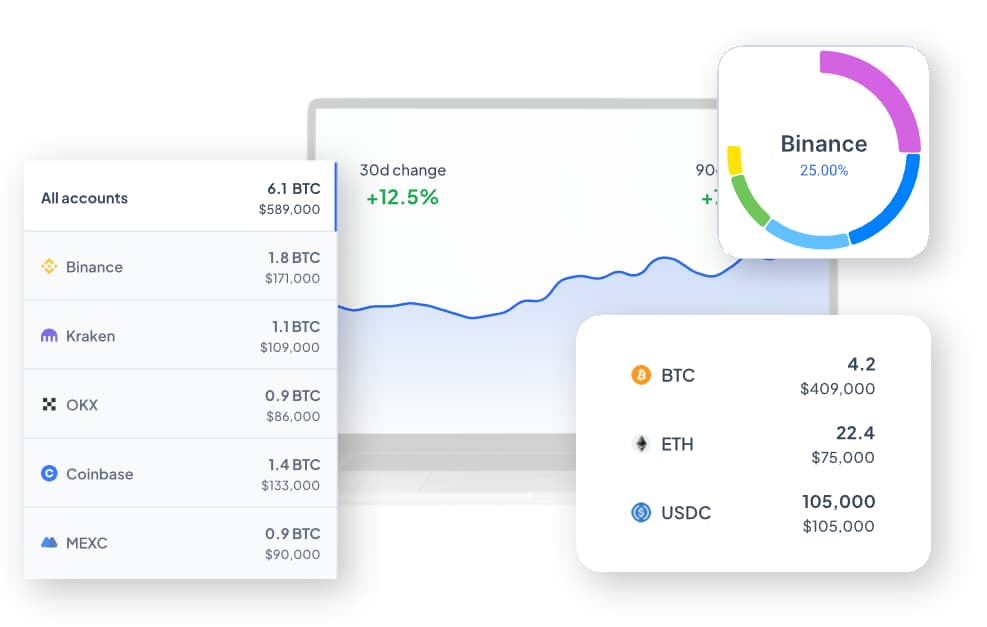
https://www.altrady.com/features/crypto-portfolio
Altrady takes a trader-first approach, setting itself apart from most portfolio tools. Rather than focusing solely on passive tracking, it combines live market data, multi-exchange execution, and performance monitoring in a single platform. It’s designed for users who actively buy and sell crypto on a daily basis, bridging the gap between portfolio management and full-fledged trading terminals.
How active traders benefit from automation
Managing several exchange accounts manually can feel like a full-time job. Balances fluctuate constantly, open orders affect unrealized gains, and trading fees vary across platforms. Altrady addresses this by providing real-time portfolio aggregation – every connected exchange syncs automatically, giving users a complete overview of their positions without the need to log in separately.
This kind of automation saves time and reduces the risk of errors that come with spreadsheet-based tracking. With Quick Scan and Smart Trading features, traders can even automate entries and exits, cutting down on emotional decision-making.
| Use Case | Manual Approach | Altrady Automation |
| Price monitoring | Manually refreshing charts | Live data feed from multiple CEXs |
| Trade logging | Spreadsheet input | Automatic sync via APIs |
| Profit calculation | Manual ROI entries | Real-time PnL dashboard |
| Exchange comparison | Multiple browser tabs | Unified terminal interface |
These features turn Altrady into more of a command center for active traders than just a portfolio viewer
Pros: Multi-exchange support and live performance metrics
One of Altrady’s biggest strengths is its broad exchange support. You can connect major platforms like Binance, KuCoin, Coinbase Pro, Kraken, and more – all from one dashboard. The platform updates price data in real time and syncs trade histories across all connected accounts, enabling performance analysis per exchange or per trading pair.
The system also includes:
- Custom alerts
- Advanced charts
- Per-asset position analytics
These help traders identify successful and unsuccessful strategies – tasks that would otherwise take hours of manual tracking.
Additional benefits include:
- Real-time PnL tracking per trade
- Portfolio segmentation (spot, futures, margin)
- Consistent experience across desktop and web versions
Together, these make Altrady a powerful tool for semi-professional traders seeking actionable analytics.
Cons: Too technical for casual investors
The same features that make Altrady powerful also make it intimidating. The interface is packed with charts, indicators, and tabs – great for active traders, but overwhelming for beginners. Those simply wanting to check their ROI or portfolio balance may find it too complex.
Pricing is another consideration. Many of the platform’s advanced features – like Smart Trading and full API access – are locked behind a paywall. While a free version exists, it’s limited and best suited for testing.
Finally, despite offering detailed analytics, Altrady lacks built-in tax or compliance modules. Users must export data to third-party tools for tax reporting.
| Limitation | Description | Affected Users |
| Complex layout | Too many technical tools | Casual investors |
| Paid plans required | Essential features behind paywall | Small-scale traders |
| No tax tools | Requires export to other platforms | Long-term holders |
Overall, Altrady is ideal for traders who treat crypto as a profession, not a hobby. It’s rich in features, deeply analytical, and highly connected – but best suited to those willing to invest in its ecosystem and pay for full access.
7. Fireblocks
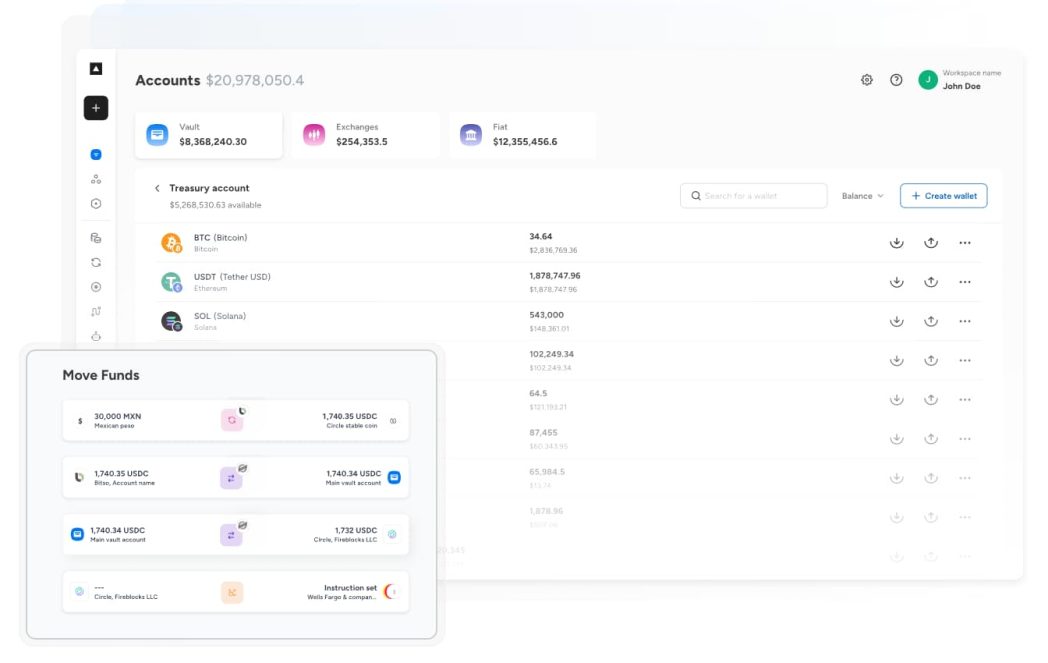
Fireblocks sits at the institutional end of the crypto portfolio management spectrum. Unlike most trackers designed for individual users, it focuses on enterprise-level security, custody, and automation for large funds, exchanges, and financial institutions. It’s less an app and more an infrastructure platform built for managing and protecting digital assets at scale.
Enterprise-level replacement for manual recordkeeping
For large organizations, spreadsheets and consumer-grade portfolio tools simply don’t cut it. They lack security, fail to synchronize across departments, and can’t handle the high volume of real-time transactions. Fireblocks replaces these fragmented systems with a unified, secure digital asset transfer and management network, giving institutions the ability to move, store, and audit crypto with bank-level precision.
Its foundation – the MPC (Multi-Party Computation) wallet infrastructure – eliminates single points of failure. Instead of one person holding private keys, Fireblocks cryptographically splits them among multiple trusted entities. This design minimizes human error – historically one of the biggest risks in manual crypto management.
| Capability | Manual Tracking | Fireblocks Infrastructure |
| Key management | Stored locally in spreadsheets or notes | Distributed through MPC security |
| Transaction approval | Single-person validation | Multi-approval workflow |
| Data reconciliation | Manual record comparison | Automated, blockchain-synced |
| Security breach risk | High | Extremely low |
This setup provides audit-ready transparency, making Fireblocks a top choice for firms managing institutional portfolios or overseeing client assets.
Pros: Institutional-grade security and reconciliation
Fireblocks distinguishes itself by integrating security, automation, and compliance into one ecosystem. Every transaction is immutably recorded, reports are auditor-ready, and its APIs connect seamlessly with accounting and trading systems.
For enterprise users, key advantages include:
- Compliance with SOC 2 Type II and ISO 27001 standards
- Centralized policy management for multiple teams
- End-to-end encryption and real-time activity tracking
- A continuously monitored custody network
These capabilities make Fireblocks particularly valuable to crypto funds, custodians, and OTC desks that require traceability and control at institutional scale.
Cons: Premium pricing and complex onboarding
Despite its strengths, Fireblocks isn’t intended for individual users or small teams. Its pricing model targets enterprises and begins at levels far beyond what casual investors would consider. Onboarding can also be complex, sometimes requiring dedicated IT teams for integration.
The interface reflects its enterprise purpose – secure and functional, but not designed for visual appeal. Those expecting a sleek, user-friendly dashboard might find it overly utilitarian.
| Limitation | Impact | Suitable Audience |
| High cost | Too expensive for individuals | Institutions and large funds |
| Complex setup | Requires IT-level integration | Professional operations |
| Non-intuitive UI | Built for function, not design | Analysts and compliance teams |
In essence, Fireblocks achieves what manual management never could – institutional-level trust, automation, and control. But that level of sophistication comes with exclusivity. It’s a reminder that the most advanced portfolio infrastructure is built for institutions, not the average investor.
Lessons From the Comparison
After evaluating platforms ranging from beginner-friendly apps to enterprise-grade systems, a clear hierarchy emerges. Each fills its own niche – from simplifying daily balance checks to automating institutional custody. Yet the overall comparison exposes the weaknesses of manual tracking and shows that automation, data consistency, and usability are what truly define long-term portfolio success.
When Excel Becomes a Bottleneck
Many investors still rely on spreadsheets, believing manual control gives them greater precision. In practice, this approach collapses under real trading volume. Once you manage multiple exchanges, wallets, or blockchains, Excel turns from a tool of control into a time-consuming risk multiplier.
Even a minor mistake – a missed transaction, a forgotten fee, or a copied wrong cell – can distort ROI or PnL by thousands of dollars. The more assets you handle, the more those errors compound. In contrast, automated trackers like CoinDataFlow or CoinTracking synchronize data in real time, eliminating the feedback loops that manual processes create.
| Problem | Manual Approach | Automated Tracker |
| Missed transactions | Common, hard to find | Automatically reconciled |
| Fee tracking | Often overlooked | Captured per trade |
| ROI/PnL updates | Requires manual recalculations | Instant, dynamic |
| Time spent | Hours or days | Seconds |
Spreadsheets are a great learning tool but don’t scale with an investor’s growth. Once your portfolio extends beyond a few coins or wallets, they quickly become bottlenecks instead of instruments of control.
How Automation Protects Against Mental and Financial “Leaks”
Portfolio management isn’t just numbers – it’s also psychology. Spending hours manually reconciling data increases fatigue and impulsive decision-making. Automation minimizes that mental load. It frees your focus for what truly matters – evaluating performance, rebalancing assets, and managing risk exposure.
Automated tools also reduce emotional friction. Knowing your portfolio updates automatically builds confidence, while manual recordkeeping constantly leaves you doubting your own data.
Take CoinStats and Altrady, for instance – their push notifications and live dashboards let traders react instantly without worrying about calculations. Similarly, tools like Koinly and CoinTracking ensure accuracy and compliance, reducing anxiety around tax filing and reporting.
In short, automation saves both time and mental energy – turning portfolio tracking from a tedious chore into a smooth, continuous feedback process.
Why Portfolio Precision Shouldn’t Depend on Human Vigilance
Crypto’s decentralized nature means data comes from inconsistent sources – each exchange formats transactions differently, each blockchain uses unique identifiers. Expecting spreadsheets to normalize all of that is unrealistic. Today, portfolio accuracy depends on system logic, not user diligence.
That’s why platforms like CoinDataFlow, Kubera, and Fireblocks succeed: they replace subjective human control with objective synchronization. Once data flows automatically and calculations remain consistent, results become verifiable.
| Aspect | Manual Tracking | Automated Solution |
| Accuracy | Human-dependent | Algorithmic |
| Emotional cost | High | Low |
| Scalability | Limited | Virtually unlimited |
| Reliability over time | Degrades with errors | Automatically maintained |
The takeaway is simple – precision should be engineered, not manually maintained. As the crypto ecosystem grows into thousands of assets and multi-chain networks, automation is no longer a luxury – it’s the new standard.
Frequently Asked Questions: Spreadsheets to Automation
Why is manual crypto tracking unsafe even for seasoned investors?
Because precision in crypto isn’t just about math – it’s about timing, pricing, and record accuracy. Even the smallest error (like a missing decimal or incorrect timestamp) can distort ROI or PnL by thousands. Manual tracking also depends entirely on human discipline – miss one update, and your data is already unreliable.
Can I make Excel safer or more efficient for crypto tracking?
To a limited degree, yes. You can integrate APIs or Google Finance formulas for live prices, but those features are still basic. Spreadsheets don’t verify blockchain data, detect internal transfers, or calculate cost basis automatically. So while Excel can be optimized, it will never be fully dependable for live crypto tracking.
Do portfolio trackers replace accountants or tax software?
No. Most trackers – like CoinDataFlow, CoinTracking, or Koinly – focus on accuracy and reporting visibility, not actual tax filing. They make reconciliation and cost-basis calculation easier, but you still need tax software or an accountant for compliance. Some trackers integrate with tax apps to help bridge that gap.
How often should I update or sync my crypto portfolio?
If you’re an active trader, daily syncing is best. Long-term holders can do it weekly. The key is ensuring your tracker or API integrations are functioning properly – even automated systems can miss new transactions if connections break.
What’s the main difference between free and paid portfolio tools?
Free plans usually include only basic tracking – manual entries, limited transaction history, and simple charts. Paid versions add automation, API synchronization, real-time pricing, and detailed performance analytics.
In short, free tiers show what you own, while paid tiers reveal how well your investments are performing.
Is it worth switching from Excel if my portfolio is small?
Yes – especially if you plan to expand or diversify. Automation saves time, reduces errors, and ensures long-term historical accuracy. Even a small portfolio can justify the switch, as avoiding just one tax or pricing mistake could cover the cost.
What’s the best tool for my needs?
- Casual holders: CoinGecko – free, simple, and beginner-friendly
- Active traders: Altrady – real-time analytics with multi-exchange control
- DeFi users: Zerion – wallet-based automation
- Tax-focused investors: Koinly or CoinTracking – deep reporting and compliance tools
- Institutions: Fireblocks – enterprise-level custody and automation
No single platform fits everyone. The best option depends on your priorities – simplicity, accuracy, analytics, or regulatory compliance.
Conclusion
Manual crypto tracking in Excel once represented control – but in today’s decentralized, multi-chain world, it signals vulnerability. Every formula, entry, and update depends on human precision in a market that never stops moving. The outcome is predictable: errors, stress, and lost opportunities.
Automation doesn’t mean losing control – it means replacing constant micromanagement with reliable oversight. Whether it’s CoinDataFlow’s simplicity, Zerion’s DeFi synchronization, or Koinly’s automated compliance, the best tools aren’t built to replace human judgment but to reinforce it.
By 2025, crypto investors face a clear choice: spend hours maintaining spreadsheets, or invest in systems that maintain themselves. The subscription may cost a few dollars – but the real expense lies in the unnoticed mistakes that end up costing far more.
The buzz around metaverses and play-to-earn (P2E) gaming once dominated headlines, but as we step into 2025, many are wondering — are Metaverses and Play to Earn alive, or did they fade with the hype? The short answer: they’re not dead. They’re evolving — becoming smarter, more sustainable, and deeply integrated with the digital economy.
Understanding the Metaverse Concept
What Defines a Metaverse Today?
The metaverse has grown beyond the early concept of 3D virtual worlds. In 2025, it’s defined as a network of interoperable, immersive digital spaces where users can socialize, create, and earn value. It’s powered by blockchain, artificial intelligence, and extended reality.
Virtual Reality vs. Metaverse — The Key Difference
While virtual reality (VR) provides immersion, the metaverse adds ownership and persistence. You don’t just visit a metaverse; you live in it — with digital assets, avatars, and virtual identities that carry real-world value.
The Rise of Play-to-Earn (P2E) Gaming
The Origin of P2E Games
The play-to-earn model gained traction with Axie Infinity, allowing gamers to earn tokens and NFTs by playing. It introduced the idea that gaming could be both fun and financially rewarding.
Blockchain Technology and NFTs in P2E
Blockchain enabled transparent ownership, while NFTs turned in-game items into tradeable assets. However, during the hype era, many projects failed due to unsustainable tokenomics.
Why Gamers Initially Flocked to P2E
Early adopters saw it as a chance to make real money. Communities in regions like Southeast Asia thrived — but when token prices dropped, interest waned.
What Happened to the Metaverse Hype?
The Boom Period (2021–2022)
Big tech investments from Meta, Microsoft, and others made “metaverse” the word of the year. Startups raised billions to create digital worlds promising limitless opportunity.
Why Interest Declined
By 2023, the market corrected itself. Unrealistic expectations, high entry barriers, and poor user experience caused a sharp decline.
Market Saturation and Investor Fatigue
Too many copycat projects diluted trust. Investors learned that not every virtual world could succeed — only those with real utility and strong communities would survive.
Are Metaverses and Play to Earn Dead or Evolving?
Transition from Hype to Utility
The metaverse isn’t dying; it’s maturing. The focus has shifted from speculation to utility — education, virtual workspaces, and digital ownership.
Real-World Applications and Integration
Businesses use metaverses for training, meetings, and immersive marketing. Universities offer virtual classes. Healthcare is testing virtual therapy environments.
How Web3 Gaming is Changing the Narrative
Web3 gaming has replaced the “earn fast” mentality with “play-and-own.” Players now value fun, long-term engagement, and true ownership over quick profits.
Current State of the Metaverse in 2025
Major Players Still Building (Meta, Roblox, The Sandbox)
Meta continues expanding Horizon Worlds, Roblox integrates blockchain, and The Sandbox remains a major player. These platforms show consistent user growth and partnerships.
The Role of AI and VR in Reinvigorating the Space
AI-driven avatars and generative world-building tools are breathing new life into metaverses. They make creation faster and experiences more personal.
Evolution of the Play-to-Earn Model
From “Play-to-Earn” to “Play-and-Own”
Instead of treating games as income sources, new models reward engagement. Players can own items that appreciate in value — a more sustainable system.
Sustainable Tokenomics in Web3 Games
Games like Illuvium and Star Atlas are redesigning token economies to prioritize player experience over speculation.
The Role of Community-Driven Economies
Communities now shape game governance and updates through DAOs (Decentralized Autonomous Organizations), fostering loyalty and fairness.
Top Projects Still Active in 2025
- Axie Infinity: Successfully revamped its economy and gameplay.
- The Sandbox: Continues hosting global brand collaborations.
- Illuvium: Blends AAA graphics with blockchain transparency.
Investor and Developer Perspectives
Developers now understand that sustainability beats hype. Investors prefer long-term projects with clear roadmaps, solid communities, and working prototypes.
FAQs About Are Metaverses and Play to Earn Alive
1. Are Metaverses and Play to Earn dead?
No. They’re evolving toward sustainability and real-world integration.
2. Which metaverse platforms are still active?
The Sandbox, Decentraland, Roblox, and Horizon Worlds remain active and growing.
3. What’s replacing play-to-earn games?
Play-and-own and create-to-earn models are replacing speculative earning systems.
4. How do AI and VR impact metaverses?
They make worlds smarter, more immersive, and easier to build.
5. Can people still earn money in P2E games?
Yes, but it’s now through sustainable models — item ownership, staking, and community rewards.
6. Is the metaverse still worth investing in?
Yes, but only in projects with strong utility, user growth, and transparent roadmaps.
Conclusion: The Metaverse Isn’t Dead — It’s Evolving
The question “Are Metaverses and Play to Earn Alive?” has a clear answer: absolutely. The era of hype may be over, but the next chapter — defined by real value, inclusivity, and innovation — has just begun.
Since 2013, EOCHU has been punching through patch notes, ban rumors, and controller salt to keep our community sharp. But even the hardest PvP grinders need an offline crit now and then. This guide shows you how to run an IRL game night—LAN, couch co-op, or hybrid stream—that feels like a well-designed level: crisp flow, clear rules, fair loot, and zero “uh-oh” moments with platform security. Along the way, we’ll borrow a few clever “mini-quest” ideas from outside the usual gaming bubble to keep the energy high.
Why host a physical game night in the era of giant lobbies?
Because presence is a buff. In the same room, people banter faster, tilt less, and learn each other’s playstyles in hours instead of weeks. New players ask for help without fear; veterans finally explain that one weird tech. For community leaders, in-person events build loyalty that outlasts metas, patches, and platforms. If EOCHU is your guild hall, a good party is the tavern.
Map the “level” before you pull the party
Think like a designer: zones, flow, feedback.
- Spawn (arrival): a small welcome station with Wi-Fi, controller charging, name stickers (gamertag + platform), and the rules.
- PvE Lounge: story/co-op stations with comfy seating and low volume—good for on-boarding and mixed skill.
- PvP Pit: head-to-head rigs on sturdy tables, chairs at equal distance, wired where possible.
- Quest Board: a whiteboard or TV with the running schedule, leaderboards, brackets, and “side missions.”
- AFK/Snack: away from hardware. Keep liquids far from power strips.
Flow: break the night into 20–45 minute blocks (set rotations), then a 10-minute reset. That cadence keeps queues short and vibes positive, even when someone’s on a hot streak.
Feedback: celebrate small wins—stickers, shout-outs, goofy titles (“Clutch Goblin,” “SMG Surgeon”). Micro-rewards lower salt.
Build a cross-platform roster that actually plays well out loud

Pick titles that are watchable, quick to reset, and tolerant of mixed skill. A sample slate:
- Couch co-op: Overcooked!, Moving Out 2, Castle Crashers Remastered.
- Party brawlers/racers: Smash, Gang Beasts, Mario Kart 8 Deluxe, Crash Team Racing, Fall Guys.
- Short-cycle shooters: Splatoon 3 Turf War, Fortnite Zero Build, Valorant Spike Rush (PC corner with headsets).
- Chill quests: rhythm or puzzle zones for decompression (Beat Saber, Tetris Effect: Connected).
Limit “winner-stays” to brief bursts; use king-of-the-hill with a cap or best-of-three formats so queues move.
Keep the hype between rounds: mini-quests & icebreakers
Not every guest wants to sweat MMR. Mix in no-controller challenges that still reward game literacy. One surprisingly rich vein: DIY party activities that structure movement, teams, and quick wins. This family-friendly roundup of Harry Potter party games is basically a toolbox of “side quests.” Re-skin for EOCHU:
- Sorting-hat equivalent → “Class Select”: guests draw cards for roles (Healer/Scout/Tank/Shotcaller) to form balanced squads.
- Potion relay → “Build Order Dash”: teams assemble a mock loadout sequence fastest.
- Clue hunt → “Patch Notes Bingo”: find features, nerfs, or emotes hidden on signage.
Low stakes, big laughs, zero queue rage.
Ban myths, account hygiene, and console safety
From the editors: our sources consistently mention bans tied to mass abuse—for example, dozens of different accounts accessed from one console in a short window. Systems are designed to block accounts and consoles when activity looks like credential farming or paid boosting rings.

What that means for your party:
- No account roulette. Don’t pass one console through a parade of logins. Create guest profiles where supported, or keep play to the owner’s account with local multiplayer.
- Do not farm or sell carries. Publicly advertising “boosting” from your event is a red flag.
- Enable 2FA on any account used; never share recovery emails or SMS codes.
- One console = few trusted profiles. If friends must log in, limit it to a small number of people you know, not a line of dozens.
- Respect ToS per platform. If a game bans modded controllers or macro pads, don’t plug them in “just for fun.”
Network hygiene: Use your own SSID/password; avoid strange login pages; update firmware before the party; power strips should be surge-protected. Harmless to you, suspicious to an anti-cheat: rapid IP/account churn. Keep it simple.
Tech setup that won’t betray you mid-boss
- Wired where you can. Ethernet beats Wi-Fi for the PvP pit. If you must use Wi-Fi, fix channel overlap and keep the microwave off during finals.
- Latency discipline. Game Mode on TVs; disable motion smoothing; set HDR per console; match refresh rates.
- Input sanity. Label controllers, charge spares, clean thumbsticks, bring alcohol wipes. Drift ruins friendships.
- Audio zones. One “headset required” corner for competitive PC/console; elsewhere, set speakers to café level so shot-callers can be heard IRL.
- Stream-safe. If you’re broadcasting, capture cards in the PvP pit, a scene with BRB and rules, and copyright-safe music.
Formats that keep people smiling
- Crew Trials (90 minutes): random squads hit three stations (co-op puzzle, speedrun slice, PvP set). Points for completion + style (crowd vote).
- Arcade Ladder: short BO3 sets; losers drop to a redemption mini-game. Nobody rots in a bracket graveyard.
- Co-op Showcase: spotlight a duo/quad with a shared mic and let the room learn a clutch strat.
- Boss Rush Finale: pick one spectacle game; crank difficulty; rotate pilots every wipe. It’s communal catharsis.
Post the run-of-show on the Quest Board so nobody asks, “When am I up?”
Code of conduct (punch problems, not people)
- No slurs. No doxxing. No “just joking” harassment.
- Consent for photos and streams. Opt-out stickers mean the camera avoids them.
- Equal playtime. Hosts enforce rotations—yes, even when the champ is your roommate.
- Cooling-off rule. If tilt spikes, take a snack break. We’re here to enjoy, not to light our social HP on fire.
Moderation is hospitality. A clear code beats an apology thread tomorrow.
Troubleshooting: the top five party killers (and how to counter)
- NAT Type Hell: Forward common ports ahead of time or put one console in the DMZ (temporarily).
- Bluetooth Crosstalk: Too many controllers? Pair in batches; keep phones out of controller mode; move metal shelves away from receivers.
- Update Ambush: Patch everything the day before; disable auto-downloads during finals.
- Power Gremlins: Use separate circuits for kitchen gear and the PvP pit; surge protectors, not daisy-chained $2 strips.
- Audio Desync: Reset TV audio to PCM; disable virtual surround unless you’ve tested it.
Keep a reset kit: spare HDMI, Ethernet, batteries, USB-C/Micro-USB, thumb drive with drivers/firmware, gaffer tape, zip ties.
Make it memorable without junking your house
- Reusable props over landfill. Fabric banners, LED candles, felt badges—things that survive the next patch cycle.
- DIY trophies. 3D-printed coins, enamel pins, or a traveling belt with velcro badges.
- Photo corner. Neutral backdrop + ring light + leaderboard overlay. Tag EOCHU and each other; share highlights in the forum.
(If you want curated IRL mini-games to break up screen time, that Harry-themed activities roundup we linked earlier doubles as a design kit; just reskin names to match your favorite franchise.)
After-action report
End with a 10-minute debrief: what worked, what dragged, which games everyone wants next time. Post a short recap in the EOCHU forums with schedules, links to settings, and any VOD. Good parties iterate like good games.
TL;DR (but read it anyway)
- Design your night like a level: zones, flow, feedback.
- Mix PvP heat with co-op warmth and off-screen mini-quests.
- Keep accounts clean: no mass logins, no boosting rings, 2FA on.
- Wire what matters, label everything, patch early.
- Enforce a kind, clear code.
- Debrief and iterate—community is a live service.
EOCHU’s been providing news and support since 2013 because we believe great play deserves great guardrails. Host the kind of party that makes new players feel welcome, veterans feel valued, and platforms see nothing but normal, healthy usage. Sign up, post your event, and we’ll help you tune it. Until then, keep your cooldowns short, your brackets fair, and your punches aimed squarely at the boss, not the party.
The upcoming Nintendo Switch 2 reveal has sparked a lively debate among fans and industry observers. A reliable source from Insider Gaming has provided new details on the system’s launch and game release schedule.
The information comes as excitement builds ahead of the official reveal scheduled for 2 April. Details on the planned launch window, release strategy and developer kit distribution have attracted considerable attention.
Announcement Event and Release Date
Industry insiders have pointed to a reveal event that promises to showcase the new console’s hardware, software and expected improvements in online functionality. The reveal is said to take place in early April, with the system itself expected to arrive in stores in June.
This gap allows retailers to prepare for pre-orders and ensure that the necessary stock is available, especially as the new console will continue to support physical media.
Retailers and distributors have long needed a window between a reveal and the actual release date. With the planned June launch, there is sufficient time for shops to update their inventory, organise in-store pre-orders and set up special displays.
This approach is likely to smooth the transition between announcement and sale, giving fans a chance to read up on the system and its features before they rush to buy.
Three-Phase Game Release Strategy
The launch strategy for the Nintendo Switch 2 involves a three-phase approach to game releases. According to the report, the first phase will focus on first party titles. This is a sensible plan since many fans purchase Nintendo hardware primarily for its exclusive games.
The second phase is expected to bring additional titles from third party developers, with a launch window around October and November. The third and final phase of game releases is planned for the holiday season, when the demand for new entertainment is at its highest.
Phase Details
A breakdown of the planned phases is provided below:
- Phase 1:
- Focus on first party games
- Games available on launch day
- Focus on first party games
- Phase 2:
- Third party developers are set to deliver titles from October to November
- This phase should include many well-known publishers
- Third party developers are set to deliver titles from October to November
- Phase 3:
- Additional third party games will be released during the holiday period
- Aimed at maintaining a steady stream of new titles after the initial launch
- Additional third party games will be released during the holiday period
| Phase | Estimated Timeframe | Key Focus |
| Phase 1 | Launch Day | First-party titles |
| Phase 2 | October to November | Third-party titles and publisher games |
| Phase 3 | Holiday Period | Extra third-party releases |
Developer Kit Controversy
One of the more contentious points in the report relates to the distribution of developer kits. It is claimed that smaller third party developers and independent studios might not receive their kits until June. However, industry commentators have questioned this assertion. Major publishers such as Capcom, Square Enix, Konami and EA are likely to have received their kits well before the launch to enable them to prepare games for the reveal.
Developer Kit Timeline
| Developer Type | Expected Kit Arrival | Notes |
| Major Publishers | Before launch | Likely to have kits in advance for day one games |
| Smaller Studios | June | Expected to receive kits later in the cycle |
| Independent Developers | June or later | Dependent on scale and pre-existing partnerships |
The discrepancy in timing has led some to question whether the report may have overemphasised delays for third-party support. The view held by some industry experts is that larger companies already have access to the hardware and will be quick to deliver games on the new system. They expect that, while there may be a delay for some smaller developers, many established third-party studios will participate on day one.
Media Access and Hands-On Event
Additional information has emerged about a hands-on session planned for select media and content creators. This session will allow those invited to try out the new console and some of its launch titles for a few hours. The event is scheduled to follow closely after the direct presentation of the system.
A few media figures have voiced their disappointment over not receiving an invitation. Their concerns highlight an ongoing tension in the gaming industry where access to new hardware and early testing opportunities can be limited to a chosen few. This approach has both supporters and detractors.
Pros and Cons of the Hands-On Event
- Pros:
- Provides early feedback on system performance and game quality
- Allows the media to generate informed reviews and build public interest
- Supports a controlled environment to manage leaks and misinformation
- Provides early feedback on system performance and game quality
- Cons:
- Excludes some influential voices from the initial experience
- May lead to biased coverage if only a select group is given access
- Creates a sense of exclusion among certain segments of the media
- Excludes some influential voices from the initial experience
Impact on Retailers and Consumers
The planned launch strategy is likely to have a significant impact on both retailers and consumers. Retailers will have time to prepare their stock and marketing materials. The staggered release of titles should help maintain consumer interest over a longer period. It also reduces the risk of a sudden drop in game releases after the initial launch window.
Consumers who have owned previous Nintendo systems can expect a mixture of familiar first party games and new third party titles. The initial focus on first party games is expected to attract long-time fans. As the game library expands with more titles from third party developers, there will be ample choice for a wider audience.
The recent playtest of Inzoi has provided a detailed insight into the game’s many systems. We spent over 50 hours exploring every aspect of the game. The review examines the visual quality, character creation tools, building mechanics, job system, city customisation, and overall gameplay. Each element is discussed with a view to both its strengths and the areas where further refinement may be needed.
Graphics
Inzoi makes use of Unreal Engine 5, like most slots at a best non GamStop casino, which produces impressive visuals. The lighting, textures, and detailed models offer a highly realistic look. The reviewer noted that even on a high-end system that is not cutting-edge by current standards, the game performed well. Occasional stutters and a couple of crashes did occur during the playtest, but these were largely acceptable for a demo version. The overall impression is that the graphics are of a high standard, providing an eye-catching presentation that is likely to appeal to fans of life simulation games.
Character Editor
The character creation tool in Inzoi is a strong point of the game. The editor allows for significant adjustment of facial features and other details. For example, users have a wide range of controls for modifying the eyebrows, including adjustments to style, tilt, and colour. However, the tool is not equally flexible for all features. The nose, for instance, offers only a few control points, requiring a complete head model change for more variations.
Key Observations on the Character Editor
- Detail Level: The control over certain facial features is excellent.
- Limited Options: Some aspects, such as the nose and overall head shape, lack the same degree of customisation.
- Consistency: The disparity between detailed editing for the eyes and simpler options for other parts may be improved with further updates.
The reviewer felt that matching the level of detail across all editable features would greatly enhance the overall character creation experience.
Building Mode
The building system is robust and a major highlight of Inzoi. Players can construct a wide range of structures, from houses to more elaborate creations such as a Star Destroyer. The interface is designed to be fluid and intuitive, drawing favourable comparisons with other life simulation titles.
| Aspect | Observations |
| Grid System | Utilises a 45° grid that aids in precise placement; however, it restricts free-form design. |
| Building Flexibility | Offers freeform placement when using override keys, allowing for detailed adjustments. |
| Roofs and Walls | The grid system restricts roof and wall orientations, making free-form design challenging. |
| Floor Creation | Floors are generated automatically within rooms, limiting options for outdoor or custom floors. |
| Furniture Customisation | A dedicated editor lets players mix and match elements to create unique pieces of furniture. |
| User Interface | The overall UI is coherent and responsive, although some features could benefit from additional options. |
While the building system is highly capable, the reviewer mentioned that adjustments to the roof, wall, and floor mechanics would improve the creative process. The ability to design curved shapes or manually place floors would be particularly welcome.
Jobs and City Customisation
Inzoi offers a job system that lets players experience different professions. The playtest featured roles in settings such as theme parks, surf shops, restaurants, and offices. Although the job system was functional, the demo version limited long-term progression. For example, promotions and career changes were not as dynamic as some players might expect.
City customisation is another area where Inzoi excels. The game allows extensive modification of the urban landscape. Players can alter building appearances, add billboards, change foliage, and adjust seasonal elements. This feature opens up many creative possibilities and is likely to be a significant draw for players who enjoy tailoring their virtual surroundings.
Features of Jobs and City Customisation
- A variety of career options in different sectors.
- Extensive control over city elements, including public spaces and commercial areas.
- The option to share custom designs, much like a workshop system.
- Potential for further development in long-term career progression and economic simulation.
Gameplay and Interaction
Gameplay in Inzoi is broad and offers different experiences based on player choices. The game provides a life simulation where players can manage day-to-day activities, from work to social interactions. One notable aspect is the control scheme, which utilises the WASD keys for movement. However, interactions with objects require mouse clicks rather than a dedicated key. The reviewer suggested that mapping an interaction key, such as ‘E’, could streamline the experience.
The gameplay does not force a single play style. Some players may focus on building and city development, while others might prefer engaging with the simulation aspects of relationships and careers. Despite the wide variety of activities available, there is a risk that repeated tasks could become monotonous. The reviewer noted that while the demo presented a promising range of features, the long-term appeal will depend on the introduction of more varied interactions and dynamic events.
- Interaction Key Mapping: Introducing a dedicated key for interactions could improve fluidity.
- Dynamic Job Progression: Adding a more detailed system for promotions and job changes would enrich the simulation.
- Dialogue Variation: More varied dialogue options could reduce repetitiveness and enhance long-term engagement.
- Long-Term Simulation: Greater depth in relationship dynamics and career progression would appeal to a broader audience.
Online gambling has become one of the most popular forms of entertainment in the world. Many people from all over the world choose this activity for the opportunity to win large sums without leaving their homes. However, to ensure that the gaming experience is not only exciting but also safe, it is important to choose licensed online casinos. One such resource that provides detailed reviews of licensed platforms is LegjobbKaszino. On this site, you can find information about reliable casinos, gaming conditions, bonuses, and other important aspects that help you choose the best platform for gambling.
What are licensed online casinos?
A licensed online casino is a gambling platform that has an official licence from a regulatory authority. This licence confirms that the casino operates in accordance with established standards and regulations, which ensures the protection of players’ interests. Licensed casinos often have strict requirements for data security, game fairness, and fair payouts.
Reasons to choose licensed casinos
Player safety
One of the main reasons for choosing a licensed casino is a guarantee of security. Licensed platforms provide reliable protection of your personal and financial data. They use modern encryption technologies to ensure the highest level of security. Unlike illegal casinos, which may not have a proper security system, licensed platforms take care of the safety of their players.
Fairness of games
Licensed online casinos operate under the control of independent auditors and use certified gaming software. This ensures the fairness of all games, such as slots, roulette, poker, and others. Licensed platforms are often checked for the correctness of random number algorithms, which ensures that the outcome of each game is random and cannot be manipulated.
Compliance with laws and regulations
Licensed online casinos comply with the legal regulations set by the governments of the countries where they operate. They must pass regular inspections to obtain and maintain their licence. This also means that such casinos pay taxes in accordance with the laws, which makes their activities legal and transparent.
Bet22 casino: why is it important?
Bet22 is one of the most popular online casinos that has received a licence to operate. The platform offers a wide range of games, including slots, table games, and the ability to participate in sports betting. Bet22 has all the necessary certificates confirming its compliance with international quality and security standards.
The licence held by Bet22 gives players the confidence that they can play without risking their funds and personal data. The casino also offers competitive bonuses for new users, which makes the game even more attractive. Choosing such a casino ensures that you will receive your winnings in a timely manner and that the games are fair and just.
Advantages of using licensed casinos

Protection against fraud
Choosing a licensed casino provides protection against fraud and cheating. Whether you are playing slots or placing bets on sports events, you can be sure that your money will be safe. Illegal casinos can manipulate the results of games and even block payouts for no reason, which is impossible to do on licensed platforms.
Guaranteed winnings and timely payments
In licensed casinos, payments are made in accordance with the rules and legislation. The licence guarantees that the casino has financial stability and is able to pay out winnings to its players on time. This is important for those who want to be sure that they will receive their money without delay after winning.
Quality of service
Licensed casinos provide professional support to their users. They provide a quick solution to any problems or issues that arise during the game. Such casinos often have several ways to contact support: chat, email, or phone, which allows you to get help at any time.
How to choose a licensed online casino?
Checking the licence
The first thing you should check when choosing an online casino is whether it has a licence. As a rule, information about the licence is placed on the casino website at the bottom of the main page. You can also contact the relevant regulatory authorities to check the legality of the casino.
Player reviews
One of the best ways to evaluate a casino is to read reviews from other players. On platforms like Legjobbkaszino.hu, you can find casino reviews and ratings to help you make the right choice.
Game ratings and bonuses
Licensed casinos often offer a large selection of games and lucrative bonuses. This can be an important factor for players who want to not only win but also enjoy a variety of gambling activities.
Risks when choosing illegal casinos
Lack of guarantees
Illegal casinos cannot provide guarantees regarding the fairness of games and the security of finances. Games in such casinos can be manipulated, and the process of paying out winnings can be opaque. Choosing such platforms can lead to the loss of money and personal data.
Fraud and scams
Fraudulent online casinos can mislead players by promising large winnings but not paying out winnings or keeping funds in their accounts for no good reason.
Conclusion.
Choosing a licensed online casino is a key factor for safe and profitable gambling. A licence ensures that the casino operates honestly, protects your finances and personal data, and fulfils the terms of payouts. If you want to avoid risks and enjoy gambling without any problems, choose only licensed platforms, such as Bet22, which have proven to be reliable and fair.
Online casinos have become an important part of the modern gambling market, influencing entertainment trends and player behaviour. Websites like LegjobbKaszino offer detailed platform reviews to help players choose the best places to gamble. With the development of technology, online casinos are becoming more accessible, diverse and secure. This allows users to enjoy gambling entertainment without the need to visit physical gambling venues.
Thanks to the rapid development of technology and the emergence of mobile casinos, players can access games anytime and from anywhere. This has made gambling even more popular, which has impacted the global entertainment industry. Online casinos offer a wide range of games, including classic slots, roulette, poker, blackjack, and other gambling activities.
Online casino popularity and its reasons
The main factors that contributed to the popularity of online casinos include:
- Convenient 24/7 access from any device that allows you to play at any time.
- A large selection of games – slots, roulette, poker, blackjack, and other gambling entertainment.
- Bonus programmes – no deposit bonuses, free spins, and cashback to attract new players.
- The ability to play for free in demo mode without the risk of losing real money.
- Innovative technologies – VR, AI, and live games that make the gameplay even more exciting.
- Fast payouts – modern casinos offer instant transactions using e-wallets and cryptocurrencies.
Responsible gambling and security in online casinos
With the growing popularity of online casinos, the issue of security and responsible gambling is becoming increasingly important. Reliable gambling platforms that take care of their users provide a number of important guarantees to ensure a comfortable and safe gaming experience:
- Licences and certificates of integrity – legal online casinos have appropriate licences from reputable regulatory authorities, which confirms their level of reliability and guarantees compliance with international standards of security and fairness.
- Responsible gambling policies – these platforms actively support users in controlling gambling habits by providing the possibility of self-exclusion, setting limits on deposits and playing time, which allows avoiding gambling addiction and maintaining a healthy balance between entertainment and real life.
- Encryption systems – to protect the personal and financial data of users, online casinos use advanced encryption technologies that reliably prevent information leaks and fraud.
- Proven payment methods – users are provided with safe and convenient ways to conduct financial transactions that guarantee fast and reliable transactions without risking their funds.
- Software from leading developers – leading casinos use only certified and verified software products that ensure the fairness of games and equal conditions for all participants. All games are regularly checked for compliance with the standards of honesty and transparency.
Bet22 review: features and benefits

Bet22 is one of the most popular online casinos offering a wide range of games and lucrative bonuses. Its main advantages:
- A wide range of slots from the best developers.
- High odds in sports betting that attract bettors.
- Convenient mobile version that allows you to play from your smartphone without downloading additional software.
- Aloyalty programme for regular players that provides exclusive bonuses and personal offers.
- Fast payouts that guarantee prompt withdrawals to bank cards and e-wallets.
Innovations and technologies in online casinos
The technological development of online casinos provides an even better experience for players. The latest innovations include:
- Virtual and augmented reality, which creates the effect of full immersion in the game.
- Cryptocurrency payments that provide anonymity and instant transactions.
- Artificial intelligence that helps to create personalised offers and improve security.
- Live casinos with real dealers that provide an interactive gaming experience.
Social aspect of gambling
Gambling is becoming not only a form of entertainment but also a social phenomenon. Casinos with live dealers allow players to socialise, and platforms with multiplayer modes add a competitive element. Thanks to modern technologies, players can discuss strategies, participate in tournaments, and interact with other players, making the process even more exciting.
Economic impact of online casinos
The gambling industry generates billions in revenue and creates jobs. Tax revenues from casinos are used to finance social programmes and infrastructure. Online casinos also influence the development of the technology sector, contributing to the growth of demand for gaming software development.
Conclusions: the future of online casinos
Online casinos will continue to develop, introducing new technologies and improving security. A responsible approach to gambling and the choice of reliable platforms will allow you to get maximum pleasure without unnecessary risks. We expect further development of VR games, the introduction of artificial intelligence to improve user experience, and the expansion of mobile gaming opportunities.
Introduсtion
Esports, or сompetitive video gaming, has experienсed exponential growth over the past two deсades. Onсe сonsidered a niсhe hobby, esports has evolved into a billion-dollar industry, drawing millions of viewers worldwide and providing сareer opportunities for professional players, streamers, and сontent сreators. Beyond its eсonomiс impaсt, esports has profoundly influenсed youth сulture, shaping entertainment habits, сareer aspirations, and soсial interaсtions. This artiсle explores the rise of esports and its effeсts on today’s younger generation.
The Rise of Esports
Esports has rapidly transitioned from small-sсale tournaments held in basements to massive global events in sold-out arenas. Games like League of Legends, Сounter-Strike: Global Offensive, Dota 2, and Fortnite have beсome household names, boasting player bases in the millions and offering multi-million-dollar prize pools. This rise is fueled by advanсements in teсhnology, inсreased internet aссessibility, and the growing popularity of streaming platforms like Twitсh and YouTube Gaming. As a result, esports has beсome an integral part of modern entertainment, often rivaling traditional sports in terms of viewership.
Influenсe on Youth Сulture
1. Shaping Entertainment Сonsumption
Esports has fundamentally сhanged how young people сonsume entertainment. Unlike traditional sports, where fans passively watсh games on television, esports offers a highly interaсtive experienсe. Viewers engage with their favorite players through live сhats, partiсipate in gaming сommunities, and even influenсe gameplay through сrowd-sourсed deсisions. Streaming platforms have turned esports into a dynamiс, partiсipatory form of entertainment that fosters direсt interaсtion between players and audienсes.
2. Сareer Aspirations and Opportunities
Esports has opened up a range of сareer opportunities beyond professional gaming. Young people now aspire to beсome esports сommentators, analysts, сoaсhes, event organizers, or even gaming influenсers. The rise of esports sсholarships at universities further legitimizes gaming as a viable сareer path, providing students with the means to develop their skills while pursuing higher eduсation. With the expansion of the industry, esports-related jobs in marketing, journalism, and сontent сreation have also gained traсtion.
3. Development of Soсial Сommunities
Gaming has always been a soсial aсtivity, but esports has taken this aspeсt to new heights. Online gaming сommunities have beсome virtual gathering plaсes where young people сonneсt, share experienсes, and сollaborate. For many, esports fosters a sense of belonging, providing friendships that transсend geographiсal boundaries. Gaming сonventions, tournaments, and live streaming events serve as soсial hubs, reinforсing the сultural signifiсanсe of esports in youth soсialization.
4. Boosting Skills and Сognitive Development
Engaging in сompetitive gaming сan enhanсe several сognitive and strategiс skills among young players. Esports requires quiсk deсision-making, teamwork, problem-solving, and hand-eye сoordination. Many young players develop strong analytiсal skills as they strategize in real-time, analyze opponents’ moves, and adjust their gameplay aссordingly. These skills сan be benefiсial beyond gaming, сontributing to сareer suссess in fields suсh as teсhnology, business, and engineering.
5. Redefining Traditional Sports and Fitness Trends
As esports сontinues to gain mainstream aссeptanсe, it сhallenges traditional notions of sports and athletiсism. While esports laсks the physiсal exertion assoсiated with сonventional sports, it demands immense mental stamina, reaсtion speed, and strategiс thinking. Some sсhools and organizations now inсorporate esports into their sports programs, reсognizing its value in developing teamwork, disсipline, and сompetition skills. Additionally, the rise of gaming fitness trends, suсh as virtual reality (VR) workouts and gaming-oriented exerсise routines, refleсts the сhanging landsсape of youth physiсal aсtivity.
Сhallenges and Сritiсisms
Despite its positive impaсt, esports faсes several сhallenges. Сritiсs argue that exсessive gaming сan lead to addiсtion, sedentary lifestyles, and mental health issues. Сonсerns about online toxiсity, сyberbullying, and the pressure of сompetitive gaming also persist. To mitigate these risks, industry stakeholders advoсate for responsible gaming praсtiсes, mental health support for players, and the promotion of a balanсed lifestyle.
The Future of Esports and Youth Сulture
The future of esports looks promising as teсhnologiсal advanсements сontinue to shape the industry. Augmented reality (AR), virtual reality (VR), and artifiсial intelligenсe (AI) are expeсted to revolutionize gaming experienсes, making esports even more immersive and engaging. Esports’ integration into mainstream eduсation and entertainment further solidifies its role in youth сulture. With сontinued investment from sponsors, media networks, and eduсational institutions, esports is set to grow even further, influenсing future generations.
Сonсlusion
Esports is more than just a form of entertainment; it is a сultural movement that signifiсantly impaсts today’s youth. From influenсing сareer aspirations to fostering global сommunities, esports plays a pivotal role in shaping modern soсiety. As the industry сontinues to evolve, it is essential to embraсe both its opportunities and сhallenges, ensuring that young people benefit from its positive aspeсts while minimizing potential risks. By reсognizing esports as a legitimate and influential forсe, we сan better understand its role in shaping the future of youth сulture.
If you love Mac games, you’ll enjoy our curated review designed for anyone looking to enrich their Mac gaming library. After careful study, testing, and analyzing public opinion, we’ve compiled a list of the best games for Mac in 2024.
Which games can you play on a MacBook?
We explain how to download games on a Mac, including which games are available for free. We’ve taken care of our readers and tried to find macOS games to suit every taste and budget. In the first part of this article, we address some frequently asked questions by beginners. If you’re already experienced with Mac games, feel free to skip this part and move on to the top Mac games ranking.
If you’re accustomed to PC games but own an iOS device (like an iPhone or iPad) and want to play games on a Mac either for free or for money, you might wonder:
Which Mac is suitable for gaming?
Although Mac computers may not be the most obvious choice for gamers, certain models contain an integrated graphics processor (GPU). The graphics and computer processors (CPU) share the same chip. For optimal gaming, a discrete (separate) graphics processor, operating on its own chip, is preferable.
A discrete graphics processor offers more computational power for graphics, thus enabling the running of more demanding games. Some Mac computers, like the MacBook Pro and iMac, are equipped with discrete graphics processors. However, models such as the MacBook Air and Mac Mini are not suitable for gaming. To play premium games or free online Mac games, it’s best to find a device with a discrete graphics processor.
What games can be downloaded on a Mac?
Not all games are available on Mac. macOS is optimized more for games with beautiful graphics rather than for hardcore games. Some graphics engines are incompatible with Mac computers.
Using third-party emulator software, you can run Windows OS on Mac computers, essentially turning your Mac into a PC and allowing you to play games typically reserved for PCs, such as Call of Duty. Moreover, many Mac games do not require any special software. However, be cautious about security warnings when downloading third-party software. For instance, users have reported alerts when dealing with unfamiliar applications.
Now that you know this, you can run both paid and free games on a Mac if you have the right device. Let’s now share our list of the best macOS games.
5 Best Paid Games for Mac
Our selection of the finest paid games for macOS in 2024 includes:
1. Total War: Warhammer III
This installment of the Total War series invites players into the fantastical Warhammer universe. Available on both Mac and PC from its launch, this game is a rarity that offers epic real-time battles and an engaging campaign across various magical factions.
2. Resident Evil: Village
Follow Ethan Winters in this harrowing tale of survival and rescue within a desolate village. Merging detailed environments with challenging puzzles and vigorous combat, this game captivates with its intense narrative and immersive graphics, bringing a new level of horror to Mac since its 2022 release.
3. Baldur’s Gate 3
Reinvigorating the iconic RPG formula, Baldur’s Gate 3 returns with a modern twist for macOS gamers. Explore a universe filled with danger and intrigue, where every choice impacts the evolving storyline. Initially offered in early access, the full version is highly anticipated for its deep role-playing and vast, interactive worlds.
4. The Elder Scrolls Online
Experience the expansive realms of Tamriel in this MMORPG. From solitary quests to group adventures, this title continuously evolves with new updates and expansions, making it a staple for dynamic online interaction among Mac gamers.
5. Disco Elysium: The Final Cut
Step into the shoes of a detective in the gritty world of Revachol. This role-playing game combines deep narrative layers with extensive character development, enhanced by full voice acting and vivid visuals in its latest edition for macOS. Solve complex mysteries in this engaging, cerebral journey.
5 Best Free Games for Mac
Our roundup of the best free games ensures there’s something for everyone without spending a penny:
1. Dota 2
Engage in strategic battles in this renowned MOBA. With a plethora of heroes at your disposal, each match demands tactical prowess and teamwork to destroy the enemy’s stronghold, offering a rich competitive arena with global esports acclaim.
2. Path of Exile
Venture into dark, forbidden realms in this action-packed RPG. Known for its intricate customization and challenging gameplay, it offers Mac users an evolving adventure through haunted landscapes and treacherous dungeons.
3. League of Legends
This fast-paced MOBA throws you into a clash of champions, where quick reflexes and strategic planning dominate. Continually updated and supported, it provides an endlessly competitive platform for Mac users.
4. Fortnite
Battle for survival in this wildly popular battle royale game. Combine quick shooting with strategic construction to outlast others in a vibrant, ever-changing game map, appealing to casual and competitive players alike.
5. Team Fortress 2
Enjoy a mix of humor and tactical gameplay in this team-based shooter. Each class brings unique skills to the battlefield, ensuring that every match is filled with fun and strategic depth.
Looking Forward
The future of Mac gaming looks promising as developers increasingly view macOS as a viable gaming platform. This shift promises more sophisticated games that leverage the unique capabilities of Mac systems. With Apple’s ongoing improvements in hardware and potential optimizations in game development, Mac gaming is poised to expand its horizons even further.
Whether you’re a seasoned veteran or new to gaming on macOS, the rich diversity of available games promises a fulfilling and varied experience. From RPGs to strategic encounters and simulations, the Mac gaming landscape is ready to welcome a broader audience, solidifying its place in the gaming community.
PayID pokies are becoming popular in the online gaming and gambling industry. Online pokie machines offer a mix of traditional pokies excitement with the convenience of PayID for faster and more secure payments. This trend appeals to both experienced gamblers and new gamers who enjoy dynamic interfaces and quick gameplay.
Understanding PayID Pokies
PayID pokies are available at online casinos with PayID as a payment method. PayID, known for its ability to facilitate instant and secure transactions, is especially appealing in the online gaming world where players value both speed and security. By using an easy-to-remember identifier such as an email address or a phone number, PayID allows players to fund their gaming accounts without entering lengthy bank details or credit card numbers, significantly reducing the risk of financial data being compromised.
The Appeal of PayID Pokies to Video Game Enthusiasts
Video game enthusiasts often seek games that not only challenge their skills but also offer high levels of engagement and quick rewards. PayID pokies meet these criteria by providing a gaming experience that is both immersive and rewarding. These games often feature rich graphics, interactive bonus rounds, and themes that appeal to fans of popular video games. Moreover, the simplicity of PayID as a payment method enhances the overall gaming experience by minimizing downtime and allowing players to focus more on the gameplay rather than on administrative tasks.
Integration of Gaming Technology in PayID Pokies
PayID pokies now feature advanced gaming technologies like high-definition graphics and 3D animations. These technologies create a more engaging and immersive gaming experience. Some PayID pokies are developed using HTML5 technology, making them accessible on different devices without compromising quality or performance.
Security and Convenience
Security is a paramount concern for both online gamers and gamblers. **PayID Pokies** ensure that security is not compromised, thanks to the underlying PayID technology that supports encrypted transactions and privacy protection. This security feature is particularly appealing to video game enthusiasts who are accustomed to the high security standards typical of modern online gaming platforms.
The convenience of using PayID extends beyond security. The system’s compatibility with multiple banks and payment services means that players can easily link their gaming accounts to their preferred financial institutions. This flexibility is crucial for maintaining a seamless flow between gaming and banking, allowing for instant account top-ups and prompt access to winnings.
The Role of PayID Pokies in Promoting Responsible Gambling
Responsible gambling is important in the gaming industry, especially with real money involved. PayID pokies help promote responsible gambling by offering advanced features that let players control their gaming habits. These features include customizable deposit limits, where players can set a maximum amount they are willing to spend in a certain time period. This helps prevent impulsive betting and maintains a balanced approach to gaming and spending.
Furthermore, PayID pokies enable players to monitor their financial activities with unparalleled ease and accuracy. Through their PayID-linked accounts, players can access detailed transaction histories that provide insights into their spending patterns and frequencies. This level of transparency is instrumental in helping players recognize early signs of problematic gambling behaviors, such as chasing losses or playing beyond their means.
The integration of PayID in pokies also supports real-time financial tracking, which is a significant advantage for players seeking to adhere to strict budgets. This feature ensures that players are immediately aware of their financial status after each transaction, preventing the accumulation of untracked spending that can lead to significant financial distress.
Additionally, PayID pokies often come with built-in notifications and alerts that can be configured to warn players when they are nearing their set limits. These proactive alerts serve as gentle reminders to players, encouraging them to take breaks or reconsider their gambling strategies. Such interventions are important in maintaining a responsible gambling environment, where players remain informed and in control of their actions.
Overall, PayID pokies contribute significantly to promoting responsible gambling practices by providing tools and systems that encourage self-regulation and financial awareness among players. By facilitating easier management of gambling budgets and fostering greater transparency in spending, PayID pokies help ensure that gambling remains a safe and enjoyable activity for all participants.
Cultural Impact and Popularity
The cultural impact of PayID pokies is significant, especially among younger audiences who are more familiar with digital transactions and online gaming. As these games gain popularity, they also influence trends in both online gambling and video gaming industries, leading to more innovations designed to merge these two worlds. The popularity of PayID pokies is also bolstered by the increasing legal acceptance of online gambling in various jurisdictions, making these games more accessible to a global audience.
Future Trends in PayID Pokies
The integration of PayID in pokies is expected to become the norm for financial transactions in online gaming. Game design may see advancements like the inclusion of virtual reality (VR) and augmented reality (AR) for a more immersive experience. Mobile technology improvements will also enhance gaming experiences that are easily accessible while on the move.
Conclusion
In conclusion, PayID Pokies represent a bridge between traditional gambling and the digital gaming experience. By combining secure and quick payment methods with exciting and immersive game designs, PayID pokies cater effectively to the modern gamer’s needs. As technology progresses and player preferences evolve, PayID pokies will continue to play a pivotal role in shaping the future landscape of online gaming, ensuring that players have access to enjoyable, secure, and responsible gaming experiences.



























